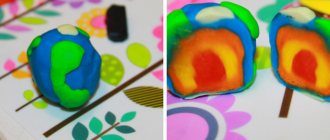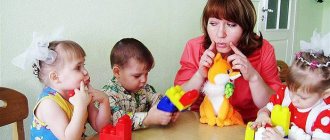Games for learning sounds article on reading (grade 1) on the topic
Games for learning sounds
One of the fundamental principles of many modern methods of teaching literacy is that the starting point in the process of developing reading skills is the analysis of spoken speech. The smallest units of speech are sounds. In this regard, among the important tasks that need to be solved during the period of learning to read and write, helping children master the sounds of their native language comes to the fore. Particular attention should be paid to ensuring that the child hears clearly, accurately identifies and pronounces sounds correctly. Without this skill, it is impossible to accurately correlate letters with the corresponding speech sounds and translate the graphic form of a word into an audio form.
The ability to differentiate speech sounds is developed through long-term exercises in isolating sounds from words. Work on developing students' phonetic hearing and developing the skill of sound analysis begins literally from the first lessons of learning to read and write, even at the letterless level. It continues during the alphabet period. However, it should be taken into account that analytical work in the lessons of this period is complicated for students by the need to distribute efforts between simultaneous solution of several problems. The child needs not only to hear, recognize and pronounce the sound correctly, but also to remember the corresponding letter and master reading words.
Games for isolating and recognizing sounds, when used regularly in lessons, will help to bring the skill of differentiating sounds to automaticity, and will also provide the opportunity to organize work in this direction in a deeper and more varied way.
The proposed games are aimed at solving the following didactic tasks:
- highlighting the first and last sounds in words;
- determining the place of the specified sound in a word (at the beginning, in the middle, at the end);
- sequential listing of all sounds in a word;
- recognition of vowels and consonants;
- recognition of hard and soft consonants;
- selection of words with a given sound;
- recognition of phonetic units such as sound and direct open syllable.
During the period of initial acquaintance with such an elementary unit of speech as sound, game situations in which onomatopoeia is used help. For example, the game situation “Flies in the Web” provides the opportunity to highlight a separate sound [zh] and train children in its pronunciation. Sound exercises in such game situations are combined with physical actions and various movements, which is especially important in the first months of training. In this case, the children are divided into two groups. Students of the first group form a circle (web), students of the second group move freely inside the circle, playing the role of flies, and quietly buzz: “W-w-w.” At the teacher’s signal, the children who have formed a circle join hands. Those who find themselves “in the web” try to escape from it and buzz harder.
You can choose many such game situations for the purpose of getting to know individual sounds:
“Ahhh!” - the child is crying; mother rocks the baby;
"Uh-oh!" - the wolf howls; the locomotive is humming;
“Shhh!” — autumn leaves rustle underfoot; the forest is noisy;
“W-w-w!” - the beetle is buzzing; bees fly;
“Ssss!” - water whistles as it flows out of the tap; steam comes out of the spout of a kettle of boiling water;
“Z-z-z!” - the mosquito rings;
“R-r-r!” - the dog growls; the motor is running;
“Hhhhh!” — the child warms his frozen hands;
“V-v-v!” — the stuck car howls;
"Mmm!" — the cow moos;
“F-f-f!” - the hedgehog snorts.
These game situations help students master “pure” sounds, understand the essence of this phonetic phenomenon, and facilitate subsequent work on isolating sound from the speech stream.
What sound is missing?
Description of the game. The teacher reads poems familiar to the children. In some of the words he does not pronounce the first sound. Children detect distorted words, pronounce them correctly and indicate which sound is missing.
For example: Our Tanya is crying loudly (crying - the sound [p] is lost).
Longer - shorter
Description of the game. The teacher names pairs of words, the children mentally compare them by the number of sounds and name which of the words is longer and which is shorter.
Put things on shelves
Equipment: subject pictures.
Description of the game. The game action is to arrange object pictures on three shelves. On the first shelf you need to put those pictures in the name of which the sound indicated by the teacher is at the beginning of the word. The second group includes those whose names have a sound in the middle. In the third place are those whose names have the sound at the end.
For example.
First shelf: hat, fur coat.
Second shelf: bear, cat.
Third shelf: hut, pencil.
Sound got lost
Description of the game. The teacher reads a poetic text. In some words it replaces one of the sounds. Children must correctly pronounce the distorted word and name the sound that “got lost” - ended up in the wrong word.
For example:
In front of the children
The rat (roof) is being painted by painters.
Clap clap
Description of the game. The teacher names the words, the children listen carefully, determine what sound they begin with. If they hear a word that begins with the sound [m1], they clap their hands once, if it starts with the sound [r], they clap twice. (What sounds and how to clap, the teacher tells you at the beginning of the game.)
Sound clock
Equipment: a model of a dial in which, instead of numbers, there are object pictures in a circle.
Description of the game. The teacher calls a “watchmaker” to the board, who, according to the teacher’s instructions, names words starting with a certain sound and places an arrow opposite the desired one.
Make up a word
Equipment: subject pictures.
Description of the game. The called student takes the picture, names the first sound of the word-name and comes up with his own word that begins with the same sound.
Have your say
Equipment: ball.
Description of the game. The teacher calls a word starting with a hard consonant sound and throws the ball to one of the students. The student catches the ball and names a word that begins with a paired soft consonant.
Whose story is better?
Description of the game. The teacher asks the children to come up with a story in which all the words begin with the same sound.
For example: Dad called Pasha. Pasha ran up to dad. Dad brought Pasha gifts. Pasha received a pistol and a steam locomotive as a gift. The pistol fires: groin - groin - groin! The locomotive puffs: puff - puff - puff!
The called student presents his story. Everyone else counts the number of words that begin with the sound indicated by the teacher. The winner is the one whose story contains the most such words.
Sound lotto
Equipment: subject pictures, chips.
Description of the game. Each student receives an envelope with subject pictures and chips. The teacher names the sounds, the children cover with chips those object pictures whose word names begin with the named sounds. The winner will be the one who covers his pictures with chips before others.
Turn down the sound
Equipment: subject pictures, chips to indicate the quality of sounds.
Description of the game. An object picture is displayed on the typesetting canvas, and next to it is a diagram of the word made up of chips. The teacher gives the command to remove a certain sound. The called student determines the count of the named sound in the word and removes the corresponding counter in the diagram.
Sonic domino
Equipment: subject pictures.
Description of the game. Pairs of pictures are displayed on the typesetting canvas: the teacher puts up any one, the called student puts next to the one whose name of the object depicted on it begins with the same sound.
Option 1 . A couple of students are working at the board.
Option 2. The desired sound in the word-name of the object depicted in the second picture can be located not only at the beginning, but also in the middle and at the end.
Parsley's magic wand
Equipment: Parsley toy, object pictures or toys, stick.
Description of the game. The teacher tells the children that Parsley has come to play words with them. Parsley will touch different objects with a magic wand, and these objects will sound. The teacher with Parsley in his hands touches the object in the picture or toy, the children pronounce the corresponding word, separately and clearly naming all the sounds.
Sound-prankster
Equipment: subject pictures.
Description of the game. The teacher reports the game situation: “Lately the sounds have not been listening to me. They began to run away from words. Help catch the mischievous people." The teacher shows the drawing and names the drawn object without saying the first sound of the word: “This is ..luch (key).” Children pronounce the word correctly and call the sound that “ran away” - [k].
First, the teacher suggests words like: ..tol - table, .lon - elephant, then - ..uritsa - chicken, etc.
The role of the teacher can be played by students called to the board - they show a picture and, naming the object depicted on it, do not utter the first sound.
The last sound in the word is behind you
Equipment: object drawings, toys. Description of the game. The teacher shows a picture, names the object depicted on it, without uttering the last sound of the name word: hundred... (table). Students complete the required sound [l] in chorus.
Fanta
Description of the game. The teacher names different words, the children clap their hands if the word contains a sound previously named by the teacher. Those who make a mistake pay forfeits. To redeem a forfeit, you must complete a phonetic task: count the number of syllables in a word, determine the stressed syllable, indicate the first (last) sound; consistently name all the sounds of the word. Class students select tasks for redeeming forfeits.
Where is the sound?
Equipment: individual typesetting canvases, chips, word charts.
Description of the game. The teacher invites students to determine the place of the sound they named in the word (at the beginning, in the middle, at the end) and, in accordance with this, place a counter on an individual typesetting canvas.
The student, when called by the teacher, goes to the board and places a chip on the word diagram.
Clap with us!
Description of the game. The teacher names the words, the children clap their hands when they hear the named sound. One of the students completes this task at the blackboard, facing the class. If he makes a mistake, the class shows him that the mistake has been noticed by shouting in unison: “Clap with us!”
Count, make no mistake
Equipment: digital cards.
Description of the game. The teacher pronounces a word, students count the sounds in it and use a digital card to show their number. The one who makes a mistake gets a chip. The winner is the row with the fewest chips.
Collect the word
Description of the game. The teacher sequentially pronounces all the sounds of the word: [a], [s], [t], [p], [a]. Children recognize the word and name it in its entirety. The one who names the word first gets a chip. The row with the most chips wins.
There may be such a variant of the game: students, when called by the teacher, pronounce the words they have conceived by sounds and call a friend who must recognize the word.
Each item has its place
Equipment: subject pictures, box.
Description of the game. Subject pictures are laid out on the table. Students one by one approach the table, take a picture, name the object depicted on it, note the presence or absence of a new (or simply named by the teacher) sound in the word. Depending on whether there is a new sound in the word or not, the object picture is either put on a typesetting canvas or hidden in a box.
A toy shop
Equipment: toys or object pictures.
Description of the game. Toys (object pictures) are displayed on the “shop window” - a typesetting canvas. You can buy the one with a new sound in its name. A student buyer approaches the display window, pronounces the name of the toy, highlighting a new sound with an amplified voice. If everything is done accurately, the seller (the teacher or a previously called student) “sells” the toy to the student, and he keeps it until the end of the day.
Who will bring the toy faster?
Equipment: toys or object pictures.
Description of the game. The game is played as a competition between two rows. From the toys (drawings) displayed on the typesetting canvas, you need to choose the one whose name contains a certain sound. Two students, called by the teacher one from each row, simultaneously begin to complete the task. The teacher calls the sound, the students try to find the toy faster. The winner (the one who finds the toy first) gets a point, which goes to the row's treasury. The row with the most points wins.
Where is the bunny hiding?
Equipment: subject pictures, a small toy hare.
Description of the game. The teacher introduces the game situation: “The bunny decided to play hide and seek with us. He hid behind a drawing whose name begins with the sound... (the teacher names the sound). Where is the bunny hiding? Students perform a sound analysis, name the object in the drawing, remove it from the typesetting canvas, and check whether the bunny is there.
Let's put the words in a basket
Equipment: two baskets, chips.
Description of the game. The teacher invites the children to come up with words that begin with a certain sound, then walks between the rows, holding a basket in their hands. Students name the words and throw chips into the basket. The number of words collected is determined by the number of chips.
The game can be played as a competition between the rows. Students name the words and throw chips into the basket of their row. The row with the most words wins.
Let's choose the words
Description of the game. At the teacher's suggestion, children come up with words with a certain sound: students in the first row - words with the named sound at the beginning, second row - in the middle, third row - at the end of the word. If the called student makes a mistake or does not say the word at all, the row receives a penalty point. The row with the fewest penalty points wins.
"Forbidden" sound
Description of the game. The teacher names the words sequentially, the children repeat only those that do not contain the sound named by the teacher.
Option 1. The teacher shows an object picture, the children either name out loud the object depicted on it if the name has a certain sound, or are silent if the name does not have this sound.
Option 2. Children come up with words that do not contain the sound named by the teacher.
Who will light the stove faster?
Equipment: magnetic board, three chips.
Description of the game. Three houses with chimneys are drawn on a magnetic board. A ladder leads to each house (the number of steps in the ladders is the same). The game is played as a competition between the rows. The teacher asks the children to come up with words with a new sound. At his signal, a student runs out from each row, calls the word and places a red chip on the first step of the ladder of the house in his row. Returning to his place, he touches his comrade, who must continue the chain of words. The student who correctly names the word moves the chip one step higher. The one who places the chip on the last step gets the right to “flood the stove,” that is, draw smoke above the chimney with chalk. The row that completes the task first wins.
Houses with ladders can be drawn on a regular board. The student who correctly names the word puts a chalk mark (cross, circle, etc.) on the step.
Don't break the chain
Description of the game. The teacher says a word. The student must choose his word so that it begins with the sound that ends the word named by the teacher: juice -> book - "bus -> table -> lemon -" .... A student who does not find the right word “breaks” the chain and pays a forfeit. At the end of the game, children buy forfeits: they determine the first sounds in words that their comrades call at the teacher’s signal.
Option 1. The game is played using subject pictures, selected in accordance with the conditions of the game and randomly placed on the typesetting canvas.
Option 2. The chain is made up of words that have the same two-letter straight syllables (mergers): frame -> machine -> pumps -> cheeses - "fish, etc.
Mom's bag
Equipment: a bag or box that plays its role, object pictures, toys.
Description of the game. The teacher reports the game situation: “Mom came from the store with a bag full of purchases. Guess what she bought if the names of purchases contain the sounds [m] and [m'].” Children select the appropriate words: butter, milk, carrots, soap, etc. Then drawings, toys or specific objects are taken out of the bag to check the correctness of the answers. The teacher changes the sound and the game continues.
Free the bird
Equipment: Cardboard in the form of a cage (vertical and horizontal strips of paper - “rods” - are glued to the cardboard at the intersections). Cardboard pictures of birds are inserted behind the rod strips.
Description of the game. The teacher tells the children that they can get the right to let the bird out of the cage. This can be done by the one who comes up with a word that contains the sound named by the teacher. The called student says the corresponding word, takes out the bird he likes from behind the striped rods of the cage. The bird stays with the child all day, and you can allow him to take it home and show it to his parents.
Sound or syllable?
Description of the game. The teacher names different sounds and straight open syllables in random order. Students raise one hand when they hear an individual sound, and both hands with intertwined fingers when they hear a syllable.
Be careful
Description of the game. The teacher names vowels and consonants separately. When he pronounces a vowel sound, the children repeat it in chorus; When a consonant sound is pronounced, children raise their hand. Occasionally the teacher raises his hand when pronouncing a vowel. The child who repeats the teacher's deceptive movement pays a forfeit, but continues to participate in the game. He can buy a phantom by naming three consonants or vowels in a row.
Let's help the postman
Equipment: envelopes with subject pictures pasted on them, a bag and a postman’s cap.
Description of the game. The teacher reports the game situation: “At the post office, letters are always sorted - distributed among cities and regions. Let's help the postman deliver letters to Glasnykh Street and Soglasnykh Street." The teacher calls the children one by one and asks them to choose envelopes from the postman's bag. Children approach two typeset canvases and place on the first canvas envelopes with drawings of objects whose names begin with vowels, on the other – envelopes with drawings in the names of which the first sound is a consonant.
Who is bigger?
Description of the game. The teacher invites two students to name in turn words in which the second sound is a consonant (school, book, class.) or a vowel (poppy, raspberry, mountains...). The one who names the most words wins.
Option 1 . The game is played as a competition between the rows. The row that names the most words wins.
Option 2. The competition is organized as follows: the first row names words in which the second sound is a vowel, the second row names words in which the second sound is a consonant.
Catch the sound
Description of the game. The teacher, swinging his hand as if to throw, names a hard or soft consonant sound - “throws” an “invisible” sound to the children. Students clap their hands in front of them and repeat the “thrown” sound in chorus - “catch” it.
Option 1. The teacher “throws” straight open syllables with a hard or soft consonant sound, and the children catch them.
Option 2. The teacher “throws” hard or soft consonant sounds, and students must “catch” only hard or only soft ones.
Option 3. The teacher “throws” a hard consonant, the children “catch” it, and “throw” a soft consonant to the teacher.
Hard - soft
Equipment: chips to indicate a hard or soft consonant.
Description of the game. The teacher pronounces hard and soft consonant sounds or words that begin with a hard or soft consonant. Students show the corresponding chip.
Stone and pillow
Equipment: cards with a picture of a stone and a pillow, a set of subject pictures.
Description of the game. On one typesetting canvas there is a drawing of a stone, on the other - a drawing of a pillow (symbols of hardness and softness). A student called to the board, having received a set of pictures, arranges them on the typesetting canvas in such a way that under the picture of a stone there are pictures depicting objects whose names begin with a hard consonant, and under the picture of a pillow - with a soft consonant. The whole class in chorus names only the first sounds of words.
Option 1 . Two students work: each fills out their own typesetting canvas. The one who completes the task first wins.
Option 2. Each student has a picture. At the teacher's suggestion, children come to the board and put a picture on the appropriate typesetting canvas.
Name a couple
Equipment: ball.
Description of the game. The teacher names hard and soft consonants separately and throws the ball to the children. The one who catches the ball must name a pair - the corresponding soft or hard consonant and throw the ball back to the teacher.
A variant of the game could be the following: the teacher calls straight open syllables with hard or soft consonants.
Who will we give what to?
Equipment: two dolls, object pictures.
Description of the game. The teacher says: “Lucy and Lara came to visit us. It's their birthday today. We will congratulate them and give them gifts, remembering that Lara likes objects whose names begin with hard consonants, and Lucy with soft consonants.” A student called to the board selects the appropriate drawing, places it next to the doll and says: “Lara (Lucy), I wish you a happy birthday! I give you a beautiful spoon (ribbon).”
Hear the difference
Description of the game. The teacher names pairs of words with similar sounds and asks to determine what sounds they differ from: house - smoke, crayfish - poppy, hands - crayfish, bow - bough, cart - carried, etc.
Sound relay race
Description of the game. The teacher names straight open syllables. Children in the first row pronounce the consonant sound of the syllable, children in the second row pronounce the vowel. Delay in pronouncing a sound is punishable by a penalty point. The winner is the row that scores the fewest penalty points.






